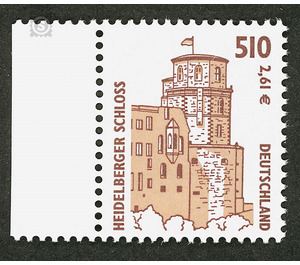Time stamp series Tourist Attractions - Germany / Federal Republic of Germany 2001 - 510 Pfennig
Theme: Art & Culture
| Country | Germany / Federal Republic of Germany |
| Issue Date | 2001 |
| Face Value | 510.00 |
| Perforation | K 14 |
| Stamp Type | Postage stamp |
| Item Type | Stamp |
| Chronological Issue Number | 2098 |
| Chronological Chapter | GER-BRD |
| SID | 595922 |
| In 24 Wishlists | |
From the 13th to the 18th century, the Heidelberg Castle experienced a particularly glamorous and varied history. The buildings from the first construction phase of the castle are simple and almost unadorned. The Ruprechtsbau, which was built from 1400, is the oldest recognizable residential building. From 1508 to 1544 the fortifications and the farm building were renewed. From 1556 to 1559 the Ottheinrichsbau was built. Elector Friedrich IV added the Friedrichsbau to the ensemble. Its façade adorns 16 artistic princely statues and a stony ancestral gallery. Under Elector Frederick V. emerged the castle garden, the English building and the Elisabethentor. The garden architect Salomon de Caus created the so-called Hortus Palatinus, which was long considered the eighth wonder of the world. In 1688/89 the castle was looted, set on fire and blown up. 1742 began the reconstruction of the castle, but in 1764 were set back. The Heidelberg Castle was never completely rebuilt and is today one of the most famous castle ruins in Europe.


